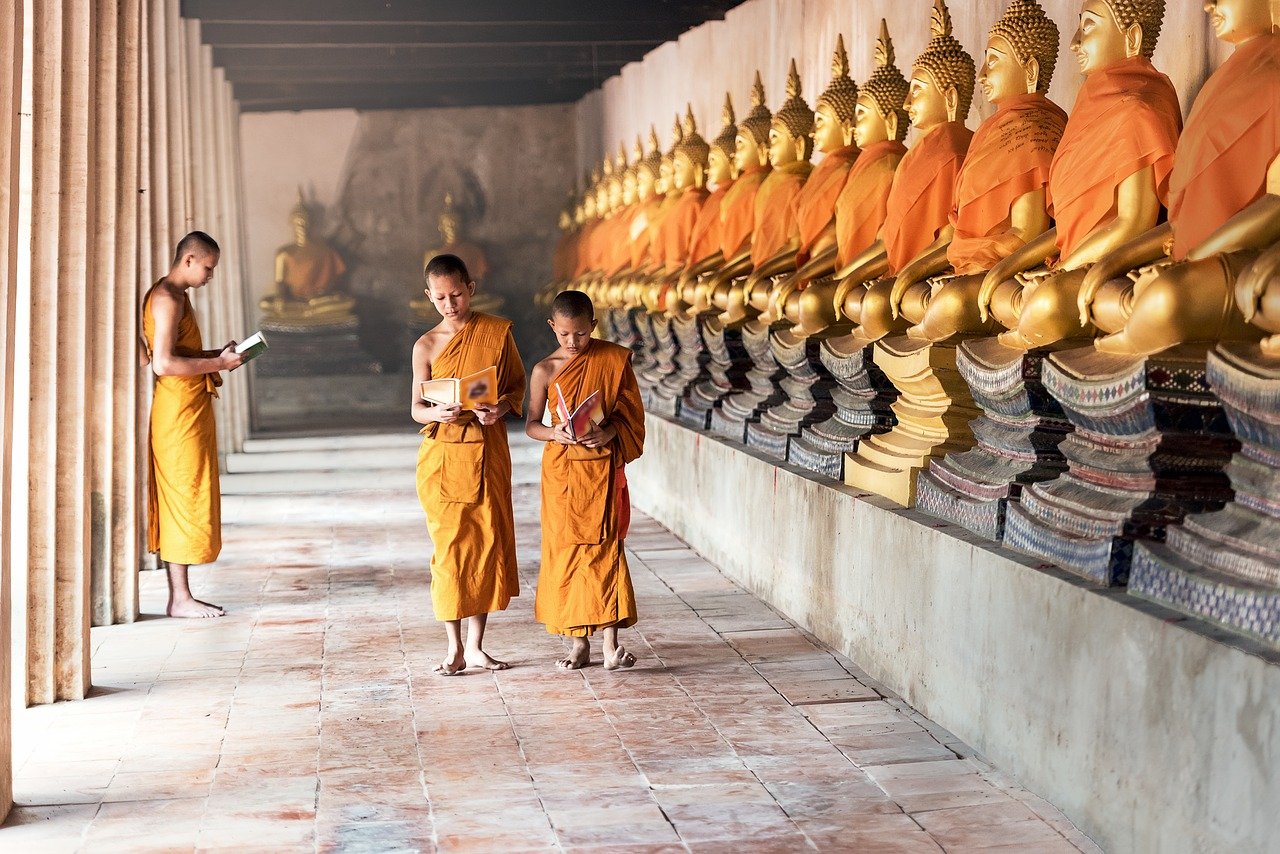Buddhism is becoming a front in the rivalry between India and China. To neglect a religious community that has pan-Asian as well as global soft power appeal will be an ill-advised step for India. India must foster a socially and economically mobile Buddhist community through intelligent investment.
On 20 October, during the Buddhist festival of Abhidhamma Day, Prime Minister Narendra Modi inaugurated an airport in Kushinagar, Uttar Pradesh. An important Buddhist pilgrimage site where the Buddha is believed to have obtained Mahaparinirvana (the final nirvana attained upon death), Kushinagar’s international airport was inaugurated in the presence of Buddhist monks from countries such as Sri Lanka, Thailand, Myanmar, South Korea, Nepal, Bhutan and Cambodia, alongside ambassadors.
This airport is the latest in a line of initiatives undertaken by the Modi government to make Buddhism a part of India’s diplomatic outreach, especially to Southeast and East Asia where most of the world’s Buddhists reside.
The promotion and utilisation of India’s historical Buddhist legacy have long been an ongoing project of Indian foreign policy as well as domestic consolidation across different ruling parties. It has a long history, covering Nehru’s relic tours to Himalayan border areas, the grand celebrations of the 2500th anniversary of the Buddha’s birth in 1956, the hosting of the Tibetan Lamas and the setting up of monastic institutions, the initiation of the now-struggling Nalanda University project begun under Manmohan Singh, and Modi’s latest Buddhist outreach.
It is no secret that Buddhism is increasingly becoming an important component of Modi’s soft power policy. This has included high-profile celebrations of Buddhist festivals, visits to Buddhist temples in Sri Lanka, China, Japan and beyond, and invoking Buddhism in public speeches.
Buddhism in India is also linked broadly to three different communities: the Himalayan Buddhists living in the border areas, the Tibetan exiles living in certain Himalayan states, and the converts from the socio-political movement led by BR Ambedkar. Leading by his own example, Ambedkar encouraged the oppressed Dalit castes to convert to Buddhism as part of their overall emancipation from casteism. In addition, most of the places where the Buddha propagated his teachings are in India – barring his birthplace, which lies in Lumbini, Nepal.
In today’s day and age, many elements make Buddhism a perfect avenue for foreign policy, public diplomacy and soft power projection. Its popular image is associated with peace and calmness. It espouses universalistic values. And Buddhism also has links to some very lucrative industries, such as religious tourism and New Age wellness, including Yoga and Vipassana retreats etc.
As far as India’s interests are concerned, the list of initiatives by various governments, on paper, would make for an encouraging read. But India needs to do more because Buddhism has – over the last 10 years – become a competitive avenue, with China also staking its claim to the legacy of Buddhism and linking it to the Belt and Road Initiative (BRI) all across Asia. This is a challenge that must be taken seriously. Otherwise, India stands to miss out on setting its own narratives across Asia’s Buddhist communities.
Top-Down Versus Bottom-Up
Most of Buddhism’s soft power promotion in the post-World War II era did not happen by government-led initiatives but by non-state entities who inadvertently helped in improving the image of their respective countries.
Japan’s Buddhist diplomacy was driven by the popularisation of Zen Buddhism by philosophers such as DT Suzuki and organisations such as the Soka Gakkai International. The Tibetan diaspora is also heavily involved in opening different centres, especially in the West. This has indirectly benefited India as well by popularising Buddhism in America and Europe and bringing India goodwill as the host of the Dalai Lama’s government-in-exile.
Officially, China’s Communist Party keeps its distance from religion. During the Cultural Revolution, most religious groups faced political repression, including Buddhists – both Chinese and Tibetan. But things changed after Mao, when economic liberalisation was also coupled with relaxation, and after 1978, Chinese Buddhists had more freedom.
In this light, the Party-controlled Buddhist Association of China has played a facilitating role in leveraging Buddhism as a diplomatic channel and mobilising Buddhists for soft power. Buddhist institutions in China were used to attract foreign investment. Indian analyst Phunchok Stobdan has termed this linkage between China’s outreach towards Buddhism and their growing economic ties with various Asian countries as “Buddhist globalisation”.
Buddhism is now a component of the BRI. While China’s earlier instances of Buddhist diplomacy included sharing relics with Myanmar, Thailand, Hong Kong and Sri Lanka, China has now included projects such as the Lotus Tower in Sri Lanka as part of the BRI. Additionally, the Chinese government is also investing heavily in Buddhist academia in order to put forth its own scholarship on Buddhism, beginning with the Nanhai Buddhist Academy which was set up as an alternative to India’s new Nalanda University.
By contrast, India’s Buddhist foreign policy is yet to incorporate the elements of 21st-century globalisation. The government’s involvement in promoting Buddhism can be useful to a certain extent; it gives a positive signal to other countries. But there is no guarantee that it would translate to deeper bilateral relations. For that, both intergovernmental and people-to-people relations are necessary.
Build on the Basics
For India to benefit from Buddhist diplomacy through such spiritual and material riches, India must not only improve on the basics of governance but also invest resources in the right places. If the law-and-order situation in Uttar Pradesh and Bihar stay as they are – with rampant crimes and communal conflagrations – the pilgrim traffic will be affected. In fact, Uttar Pradesh saw an outbreak of violence between Hindus and Buddhists only very recently. Incidents such as these will deter pilgrims – especially those from countries like Japan, Thailand and South Korea who are used to far higher standards of living.
India’s Buddhist diplomacy, however, cannot simply revolve around tourism. There is immense potential to utilise Buddhism as a channel for cultivating strong people-to-people contact. For this, the government needs to invest more in developing Buddhist academic institutions which can attract students from all over Asia, if not the world. The current initiative – Nalanda University – is riddled with multiple academic and political issues. It seems that despite all the Buddhism-related public messaging, there is much to be done.
A better and more equitable economy is just as necessary, because there must be a prospering Indian Buddhist community with disposable income. This does not mean simply the Tibetan exile community, but also the broader Buddhist community within India. Buddhism, as pointed out by former bureaucrat Jayadeva Ranade, is becoming a front in the rivalry between India and China. To neglect a religious community that has pan-Asian as well as global soft power appeal will be an ill-advised step for India.
The dynamism of Buddhism lies in its ability to bring into conversation diverse traditions from different religions and cultures across Asia: Hinduism, Confucianism, Taoism, Shintoism, Tengrism and the Bon religion. These religious cultures have porous spiritual boundaries with Buddhism, enabling the creation of bilateral and multilateral spaces for engagement. For India to utilise this, Buddhism cannot be treated as a government information program. India must create conditions that foster a socially and economically mobile Buddhist community through investment in infrastructure and institutions.
Shivam Bahuguna is currently pursuing a PhD in International Relations from South Asian University. His academic interests include geopolitics, politics of culture and media. He also likes to occasionally strum on his guitar and sing.


